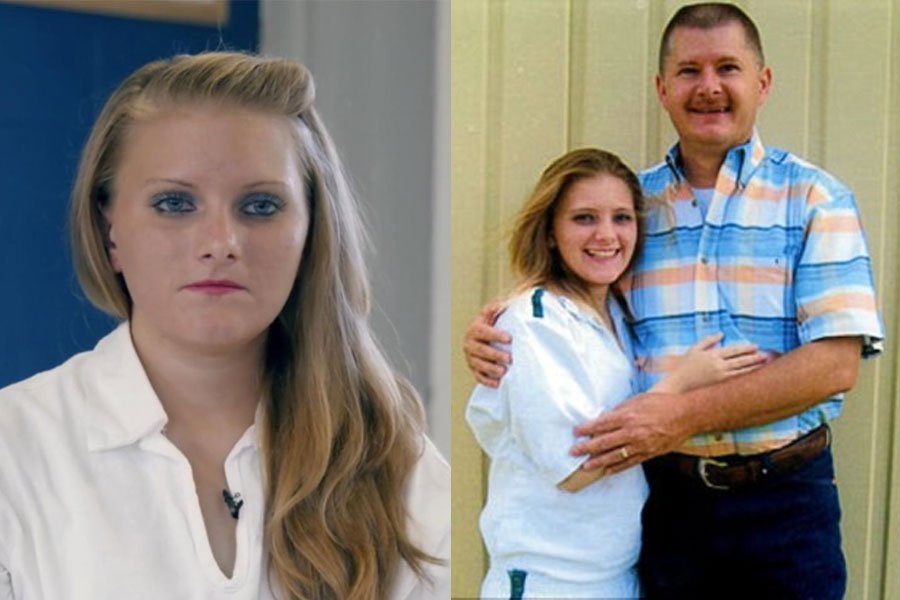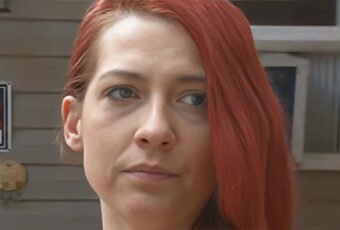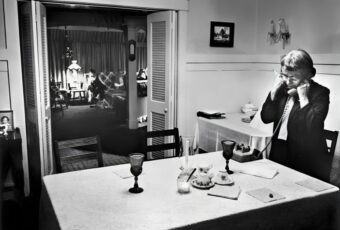In the quiet hours before dawn on March 1, 2008, a small Texas town was shaken to its core by a crime so heinous it seemed ripped from the pages of a horror novel. The Caffey family, known for their deep faith and close-knit bonds, became the centre of a shocking criminal case that would leave the nation grappling with a chilling question: How could a seemingly normal teenager orchestrate the brutal murder of her own family?
The Caffey Family: A Portrait of Rural Texan Life
Nestled in the small, tight-knit community of Alba, Texas, the Caffey family was a picture of rural America. Terry and Penny Caffey, the patriarch and matriarch, were known for their devout Christian faith and dedication to their family. They lived a simple yet fulfilling life, deeply intertwined with their small town’s values and local church.

Their home was a modest one, but it was rich with the sounds of laughter and music. Music, in particular, played a central role in the family’s life, with each member contributing their unique talent. Penny, a talented pianist, often led the music at their church. At the same time, the children, Erin and her two younger brothers, Tyler and Matthew, were also musically inclined, with interests ranging from singing to playing various instruments.
Erin Caffey: The Early Years
Erin Caffey, born on July 27, 1991, grew up as the eldest child in this harmonious setting. Described by those who knew her as a sweet and obedient daughter, Erin seemed to symbolise the values her parents held dear. She had a voice that could captivate an audience and was often at the forefront of church performances, singing with a purity that belied her young age.
In her early years, Erin’s life revolved around her family, church, and school. She was homeschooled, which allowed her a close-knit educational environment, further strengthening her family bonds. Her parents, keen on providing a wholesome upbringing, were attentive and involved in their children’s lives, ensuring they grew up with strong moral and religious foundations.

The Caffeys were not just a family; they were an integral part of their local church community. Their faith was not merely a part of their life; it was their way of life. Terry and Penny were deeply involved in church activities, from organising events to leading worship sessions. This involvement was a family affair, with Erin and her brothers often participating in church plays, musicals, and youth groups.
Their home was a reflection of their faith, with Bible studies and prayer sessions being a regular part of their routine. The Caffeys were viewed by many in their community as a model Christian family, embodying the values and principles of their faith.
However, beneath this seemingly perfect shell, dynamics were shifting, especially as Erin entered her teenage years. The transformation from a child to a teenager brought new challenges and changes in Erin’s behaviour and choices, which would eventually lead to a tragic unravelling of the family fabric.
How Erin Met Charlie Wilkinson
The trajectory of Erin Caffey’s life took a dramatic turn with the entry of Charlie Wilkinson into her world. Their paths crossed when Erin was 16, a time when teenage curiosity and the desire for independence were at their peak. Charlie, who was 18 at the time, met Erin while she was working part-time at a local Sonic fast-food restaurant. This encounter marked the beginning of a relationship that would have catastrophic consequences.

Charlie Wilkinson, a local boy, was different from the people Erin was accustomed to in her church-centred social circle. He was older and, in many ways, represented the allure of a world outside the protective bubble in which Erin had been raised. Their connection was instant and intense, quickly evolving from casual acquaintances to something much deeper.
The Nature of Erin and Charlie’s Relationship
As Erin and Charlie’s relationship developed, it became a focal point of Erin’s life, overshadowing her family, school, and even her involvement in church activities. Friends and family noticed a change in Erin; she became more secretive and less engaged with her usual routines. The relationship, while seemingly typical of teenage romance on the surface, had an undercurrent of intensity that raised eyebrows among those who knew Erin well.
Charlie gave Erin a promise ring that had belonged to his grandmother, a gesture that symbolized a deep commitment at their young age. This act of devotion was a clear indication of how serious their relationship had become. However, this intensity was not without its problems. The relationship began to exhibit signs of being tumultuous and all-consuming, with Erin increasingly prioritizing Charlie over other aspects of her life.
Parents’ Concerns and Discovery of Troubling Signs – Erin’s parents, Terry and Penny Caffey, initially welcomed Charlie, but it didn’t take long for them to sense that something was amiss. They observed changes in Erin’s behaviour that were concerning: her academic performance began to slip, and her involvement in church activities waned. Terry, in particular, harboured reservations about Charlie, sensing that his influence on Erin was not positive.
Determined to understand the nature of this relationship better, Terry and Penny decided to investigate further. They turned to the internet, and what they found was alarming: Charlie’s MySpace page was filled with references to alcohol and sexual content, starkly contrasting the values they had instilled in their daughter.
This discovery was a turning point. Concerned for their daughter’s well-being and future, the Caffeys insisted that Erin end her relationship with Charlie. This demand, meant to protect Erin, was met with resistance and anger, setting the stage for a conflict that would escalate beyond anyone’s worst fears.
The relationship between Erin and Charlie Wilkinson, once a source of joy and excitement for Erin, had now become a point of contention, creating a rift between her and her family. This rift would widen, leading down a path of rebellion, secrecy, and ultimately, tragedy.
Erin’s Behavioral Changes and Decline in Academic Performance
As Erin Caffey’s relationship with Charlie Wilkinson deepened, notable changes began to emerge in her behaviour and life choices. Previously a diligent student, Erin’s academic performance started to decline. This was a significant shift for someone who had been homeschooled and whose education was a central part of her upbringing. Her focus on schoolwork waned, and her grades began to suffer, a red flag for any parent, but particularly alarming for Terry and Penny Caffey, who had invested so much in their children’s education.
Alongside her academic struggles, Erin’s demeanour at home and in her community also changed. She became more withdrawn and less communicative with her family. The once vibrant and active participant in church activities started to recede into the background, skipping events she would have previously attended with enthusiasm. This withdrawal was not just from the church but from the family unit itself, as she spent more and more time away from home, often with Charlie.
The Growing Tension Between Erin and Her Parents
The discovery of Charlie Wilkinson’s MySpace page and the content it contained only added fuel to the growing fire of discord within the Caffey household. Erin’s parents, deeply concerned by what they perceived as a negative influence on their daughter, took a firm stance. They demanded that Erin end the relationship, a directive that was met with resistance and anger from Erin.
This conflict marked a significant turning point in the family dynamics. The once harmonious household was now a battleground of wills, with Erin increasingly defying her parents’ wishes. The Caffeys, standing by their principles and beliefs, remained firm in their decision, leading to heightened tensions and frequent arguments. The household that was once filled with music and laughter began to echo with the sounds of discord.
Erin’s Discussions About Killing Her Parents
In what would later be seen as a chilling precursor to the tragic events that followed, Erin began to express unthinkable thoughts to her friends. She started talking about killing her parents. While it’s not uncommon for teenagers to express hyperbolic statements in moments of anger or frustration, Erin’s words were different. They were specific and persistent, indicating a level of seriousness that was deeply concerning.
These discussions were not mere venting of teenage angst; they were detailed and deliberate. Erin spoke about the idea as a solution to her problems, a way to be with Charlie without her parents’ interference. To her friends, these conversations may have seemed like dramatic exaggerations, but in hindsight, they were a clear warning sign of the darkness that had taken root in Erin’s mind.
The combination of Erin’s behavioural changes, her declining academic performance, the growing tension with her parents, and her alarming discussions about killing them painted a picture of a young woman in turmoil. This turmoil, however, was not just a teenage phase; it was a descent into a darkness that would soon culminate in an unimaginable tragedy.
As Erin Caffey’s relationship with Charlie Wilkinson deepened, notable changes began to emerge in her behaviour and life choices. Previously a diligent student, Erin’s academic performance started to decline. This was a significant shift for someone who had been homeschooled and whose education was a central part of her upbringing. Her focus on schoolwork waned, and her grades began to suffer, a red flag for any parent, but particularly alarming for Terry and Penny Caffey, who had invested so much in their children’s education.
Alongside her academic struggles, Erin’s demeanour at home and in her community also changed. She became more withdrawn and less communicative with her family. The once vibrant and active participant in church activities started to recede into the background, skipping events she would have previously attended with enthusiasm. This withdrawal was not just from the church but from the family unit itself, as she spent more and more time away from home, often with Charlie.
The Involvement of Charlie Wilkinson and Charles Waid – As the conflict between Erin Caffey and her parents reached a boiling point, the dynamics of her relationship with Charlie Wilkinson took a dark and sinister turn. It was during this period of intense emotional turmoil that Charlie Wilkinson and his friend, Charles Waid, became key figures in a plot that would shock the community to its core.
Charlie Wilkinson, already a significant influence in Erin’s life, became a co-conspirator in her growing resentment towards her parents. His role in the plan was not just that of a supportive boyfriend; he was an active participant in the discussions and eventual execution of the plot. Charles Waid, a friend of Wilkinson’s, was brought into the fold, adding another layer of complexity and danger to the situation.
The Formation of the Murder Plot – The plot to murder Erin’s family was born out of a combination of teenage rebellion, misguided love, and a desire for autonomy. Erin, feeling cornered by her parents’ insistence on ending her relationship with Charlie, saw an extreme and tragic solution to her dilemma.
The plan was chilling in its detail – It involved attacking the Caffey family in their home, ensuring that no witnesses were left behind. This meant not only targeting Erin’s parents but also her younger brothers. The level of planning indicated a cold and calculated approach, far removed from the impulsive actions often associated with teenage behaviour.
The Role of Each Individual in the Plan – In the murder plot, each individual had a specific role. Erin Caffey, the mastermind behind the plan, orchestrated the events and provided inside information about the family home and the sleeping arrangements of her family members. Her role was pivotal in planning the attack, as she had intimate knowledge of the household.
Charlie Wilkinson’s role was that of the primary executor of the plan. He was to carry out the physical act of murdering the Caffey family members. His commitment to Erin and his willingness to participate in such a heinous act reflected the depth of his involvement in the relationship and the plot.
Charles Waid, as an accomplice, was involved in the planning stages and assisted Wilkinson in carrying out the murders. His participation displayed the extent to which the plot had been thought out and the level of commitment from all involved.
It was a plan that, once set into motion, would have irreversible consequences, not only for the Caffey family but for the small community of Alba, Texas, and all those connected to this tragic story.
The night of the murders
The night of March 1, 2008, marked the horrific culmination of the murder plot against the Caffey family. As the family slept in their rural home in Alba, Texas, a sinister plan was set into motion by Erin Caffey, her boyfriend Charlie Wilkinson, and his friend Charles Waid.
In the dead of night, Wilkinson and Waid, armed and prepared for the gruesome task ahead, approached the Caffey household. Erin, who had intimate knowledge of the house and the sleeping arrangements of her family members, played a crucial role in facilitating the attack. She remained outside, a silent guardian to the unfolding tragedy.
The Roles Played by Wilkinson, Waid, and Erin – Charlie Wilkinson and Charles Waid entered the Caffey home with a chilling resolve. Wilkinson, carrying a .22 caliber handgun, made his way to the bedroom of Erin’s parents, Terry and Penny Caffey. Without hesitation, he opened fire, shooting Terry and Penny as they slept. Terry was critically injured but miraculously survived, while Penny succumbed to her injuries.
After attacking Erin’s parents, Wilkinson’s gun jammed, leading Waid to take over with a samurai-style sword. In a brutal and senseless act, Waid used the sword on Penny, inflicting fatal wounds. The pair then moved to the bedrooms of Erin’s younger brothers, Tyler and Matthew. In a heartbreaking turn of events, both children were brutally murdered, ensuring there were no witnesses to the crime.
Erin’s role in the murders was not of direct violence but of orchestration and facilitation. By providing information and planning the attack, she was complicit in the actions of Wilkinson and Waid.
The Aftermath of the Crime and Terry Caffey’s Survival – After the murders, Wilkinson and Waid set the Caffey home ablaze, intending to destroy evidence of their heinous act. They fled the scene, believing all members of the family were dead. However, in a remarkable turn of fate, Terry Caffey, despite being shot multiple times, survived.
Severely wounded and fighting for his life, Terry managed to escape the burning house. He crawled through the woods to a neighbor’s house, nearly a quarter-mile away. His escape and subsequent call for help were crucial in the immediate response of emergency services and law enforcement.
The aftermath of the crime was a scene of devastation. The Caffey home was reduced to ashes, and the small community of Alba was left reeling from the shock of such brutality in their midst. The investigation that followed would soon uncover the chilling truth behind the murders, revealing a plot driven by teenage rebellion, misguided love, and a disturbing willingness to resort to violence.
Investigation and arrest
In the immediate aftermath of the Caffey family murders, local law enforcement, led by the Rains County Sheriff’s Department, launched a comprehensive investigation. The crime scene presented a harrowing tableau: a burned-down house and the tragic loss of Penny, Tyler, and Matthew Caffey. The survival of Terry Caffey, despite his severe injuries, provided the first critical lead in the investigation.
Forensic teams meticulously searched through the charred remains of the Caffey home, searching for evidence. Simultaneously, detectives began piecing together the events leading up to the murders. They conducted interviews with neighbors, friends, and members of the church community, building a timeline and searching for motives.
Identification and Apprehension of the Suspects – The breakthrough in the case came from Terry Caffey’s testimony. Despite his critical condition, Terry was able to provide law enforcement with crucial information. He identified Charlie Wilkinson as one of the attackers, a revelation that shifted the focus of the investigation towards Erin’s boyfriend.
Armed with this information, the police quickly located and apprehended Charlie Wilkinson. Further investigation led them to Charles Waid, who was also taken into custody. The evidence against them began to mount, including physical evidence from the crime scene and incriminating statements from the suspects themselves.
However, the most shocking development was yet to come. As the investigation progressed, Erin Caffey’s involvement in the plot began to unravel. Initially viewed as a possible victim, Erin quickly became a suspect as her relationship with Wilkinson and her behavior prior to the murders came to light.
Erin’s Initial Claims of Kidnapping – When Erin was found by the authorities, she was in a state of apparent shock and distress. She initially claimed that she had been kidnapped by Wilkinson and Waid, painting herself as an unwilling participant in the events of that night. This claim, however, began to crumble under scrutiny.
As detectives delved deeper, inconsistencies in Erin’s story emerged. Testimonies from friends and acquaintances painted a picture of a troubled relationship between Erin and her parents and her increasing estrangement from them. The most damning evidence came from the confessions of Wilkinson and Waid, who implicated Erin as the mastermind behind the murders.
The revelation of Erin’s involvement sent shockwaves through the community and her family. The idea that a 16-year-old girl could orchestrate such a heinous crime against her own family was almost incomprehensible. Yet, as the investigation continued, the evidence against Erin mounted, leading to her arrest and subsequent charge for her role in the murders.
The Trial and Sentencing
The trial of Erin Caffey, Charlie Wilkinson, and Charles Waid was a highly publicized and emotionally charged event. Prosecutors presented a case that painted a detailed picture of the events leading up to and including the night of the murders. Central to their argument was the role of Erin Caffey as the mastermind behind the plot. The defence teams, on the other hand, attempted to mitigate the culpability of their clients, focusing on their young ages and psychological states.
Charlie Wilkinson and Charles Waid both received life sentences without the possibility of parole. Their direct involvement in the murders and the premeditated nature of their actions warranted the maximum penalty under the law.
Erin Caffey, despite being a minor at the time of the crime, was also handed a heavy sentence. She received a life sentence with the possibility of parole after 40 years. This sentence was a reflection of her role as the instigator of the plot and her betrayal of her own family.
For Terry Caffey, the trial was a heart-wrenching ordeal. Having lost his wife and two sons in such a brutal manner, and then learning of his daughter’s involvement, was an unimaginable burden. The trial forced him to relive the events of that tragic night and confront the reality of his daughter’s betrayal.
Amidst the unfolding of these grim details, one of the most poignant aspects of the case was the response of Terry Caffey, Erin’s father and the sole survivor of the attack. Despite the overwhelming evidence of Erin’s involvement and the unimaginable betrayal and loss he suffered, Terry found it in his heart to forgive his daughter.

Terry’s journey to forgiveness was rooted in his deep Christian faith and his belief in redemption and mercy. He publicly forgave Erin and the others involved in the murder of his family. This extraordinary act of forgiveness was not just a personal coping mechanism for Terry; it was a powerful statement about the capacity for forgiveness and compassion in the face of unspeakable tragedy.
Terry’s decision to forgive was also reflected in his intervention during the sentencing phase of the trial. He requested that the death penalty not be applied to the perpetrators, including the individuals who directly murdered his wife and sons. This act of mercy was a testament to his character and his commitment to his faith, even in the darkest of times.
Read more from the website:










